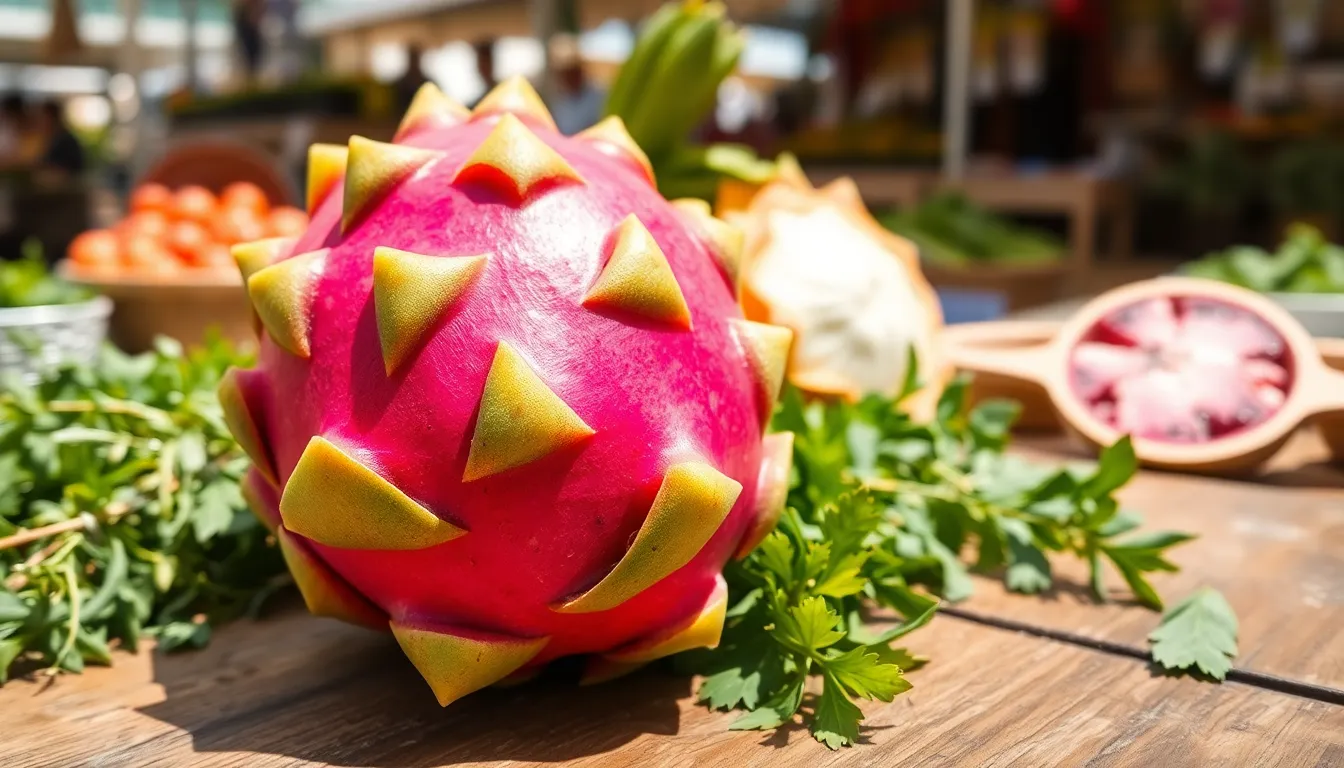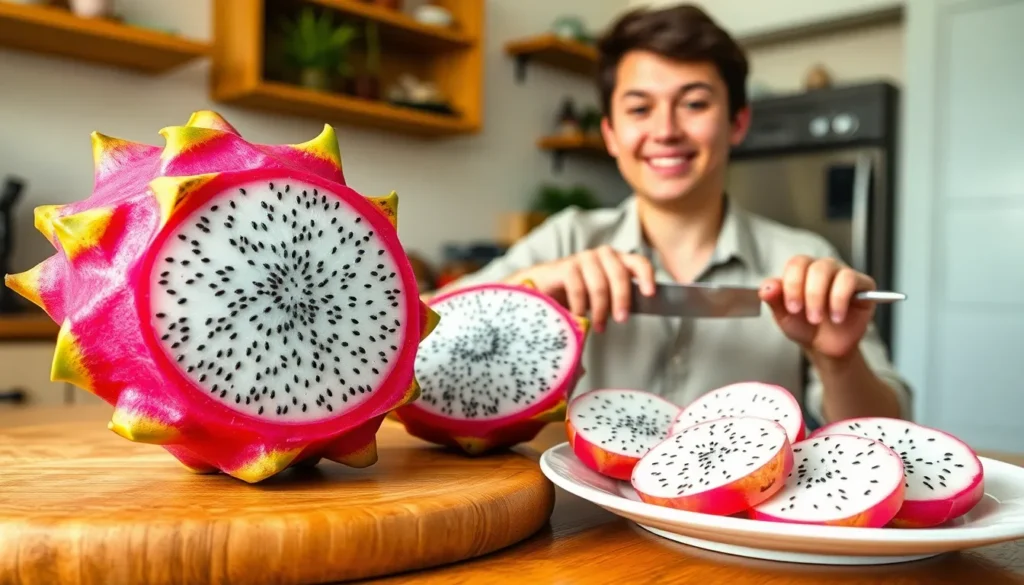Dragon fruit, with its vibrant pink skin and exotic green scales, looks like something straight out of a fantasy novel. But don’t let its mythical appearance intimidate you; eating this delightful fruit is easier than you think. Packed with nutrients and a subtly sweet flavor, dragon fruit is a tropical treat that deserves a spot in your diet—and on your Instagram feed.
Table of Contents
ToggleUnderstanding Dragon Fruit
Dragon fruit captivates with its unique look and impressive health benefits. This exotic fruit boasts vibrant pink skin and striking green scales, making it intriguing yet approachable for consumption.
What Is Dragon Fruit?
Dragon fruit, also known as pitaya, is the fruit of several different cactus species native to Central America and Asia. This fruit features a sweet, creamy texture and comes in several varieties, including white-fleshed and red-fleshed types. Some varieties even possess a small number of black seeds, enhancing its crunch. Many people enjoy dragon fruit fresh or incorporate it into smoothies, salads, and desserts. Its striking appearance appeals not only to taste buds but also to those eager to showcase healthy choices on social media.
Nutritional Benefits of Dragon Fruit
Dragon fruit offers a balanced array of nutrients. This fruit contains vitamin C, fiber, antioxidants, and healthy fats. One cup (approximately 227 grams) provides around 60 calories, 3 grams of fiber, and a significant amount of vitamin C, meeting about 7% of the daily recommended intake. Antioxidants found in dragon fruit help combat oxidative stress, boosting overall health. Fiber promotes digestion, making it beneficial for gut health. Regular consumption of dragon fruit strengthens immune function and encourages skin health as well.
Selecting the Right Dragon Fruit

Choosing the right dragon fruit enhances the eating experience. Ripe fruit displays certain characteristics that indicate its readiness for consumption.
Characteristics of Ripe Dragon Fruit
Ripe dragon fruit features vibrant skin, often bright pink or yellow, coupled with green, spiky scales. A slight squeeze indicates ripeness; it should yield slightly without feeling mushy. Bright color and slight give suggest balanced sweetness and optimal texture. Dark spots may signal overripeness, while hints of browning suggest it’s past its prime. Selecting fruit with fresh-looking scales will improve quality.
Where to Buy Dragon Fruit
Finding dragon fruit is easier in specialty grocery stores or local farmers’ markets. Popular grocery chains often stock fresh varieties, particularly during peak season. Asian markets frequently offer lower prices and higher quality. Online retailers provide convenience, shipping directly to doorsteps for those who can’t find it locally. Looking for organic options can enhance the health benefits and flavor.
Preparing Dragon Fruit for Eating
Preparing dragon fruit for eating requires careful washing and cutting techniques. These steps ensure the fruit is clean and easy to enjoy.
Washing and Cleaning the Fruit
Washing dragon fruit is essential to remove dirt and potential pesticides. Rinse the outer skin under cool running water for about 30 seconds. Scrubbing with a vegetable brush can help clean stubborn spots. After rinsing, dry the fruit with a clean cloth or paper towel. Proper cleaning enhances both safety and flavor.
Cutting Techniques for Dragon Fruit
Cutting dragon fruit can be done in several ways. First, place the fruit on a cutting board. A sharp knife makes the process easier. Cut the fruit in half lengthwise to reveal the vibrant flesh inside. Alternatively, slice it into quarters for easier handling. The skin is often discarded, as only the fleshy insides are consumed. Spoons can scoop out the flesh for a neat serving or salad preparation. Enjoying dragon fruit fresh or adding it to dishes maximizes its unique taste and texture.
Ways to Eat Dragon Fruit
Dragon fruit offers various enjoyable ways to savor its unique flavor and texture. Fresh consumption or creative culinary applications enhance the overall experience.
Eating It Raw
Eating dragon fruit raw showcases its natural sweetness and creamy texture. The vibrant flesh, whether white or red, provides a refreshing snack. Simply scoop or slice the flesh into bite-sized pieces to enjoy. Many prefer pairing it with lime juice or a sprinkle of salt for added flavor. It also serves as a colorful addition to fruit bowls and platters, making it appealing for gatherings.
Incorporating Dragon Fruit into Recipes
Incorporating dragon fruit into recipes enhances both taste and presentation. Smoothies benefit from its creamy consistency, while salads gain vibrant color and a subtle sweetness. Consider blending dragon fruit with yogurt, spinach, and banana for a nutritious breakfast option. Baking also welcomes dragon fruit, as it can enrich cakes and muffins with moisture and a hint of sweetness. Finally, topping desserts like panna cotta or ice cream with dragon fruit elevates their visual appeal and introduces exotic flavors.
Common Mistakes to Avoid
Mistakes can creep in when eating dragon fruit, especially with its unique qualities. Understanding these common pitfalls can enhance the overall experience.
Misunderstandings About Dragon Fruit
Many people believe dragon fruit lacks flavor due to its bright appearance. In reality, this fruit has a subtly sweet taste that varies between its varieties. To maximize flavor, pairing it with lime juice turns a good food experience into a delightful one. Not recognizing the texture is another misunderstanding. Its creamy flesh contributes to a refreshing experience, which is often overlooked. Misconceptions about its preparations also exist. Properly handling and cutting the fruit can elevate any dish, yet some may skip important steps.
Overripe vs. Underripe Fruit
Distinguishing between overripe and underripe dragon fruit proves crucial for enjoyment. An overripe fruit often displays dark spots and has a pungent odor. Choose fruits that present vibrant colors and yield slightly when squeezed for the best experience. Underripe dragon fruit feels firm and lacks the desired sweetness. Selection based on skin condition simplifies finding the perfect piece. Consuming a ripe dragon fruit ensures the best flavor and texture, while harvesting improperly can hinder the overall eating experience.
Dragon fruit is not just a feast for the eyes but also a delightful addition to any diet. Its unique flavor and health benefits make it a standout choice for anyone looking to enhance their meals. By selecting ripe fruit and preparing it properly, one can truly enjoy all that this exotic fruit has to offer.
Whether eaten fresh or incorporated into various recipes, dragon fruit brings a refreshing twist to everyday dishes. Its versatility allows it to shine in smoothies, salads, and desserts alike. With its vibrant colors and subtle sweetness, dragon fruit is sure to impress both palates and social media feeds. Embracing this fruit can elevate one’s culinary experience while promoting overall health.








